Type Barque Length 55 m | Namesake Picton Castle Beam 7.3 m | |
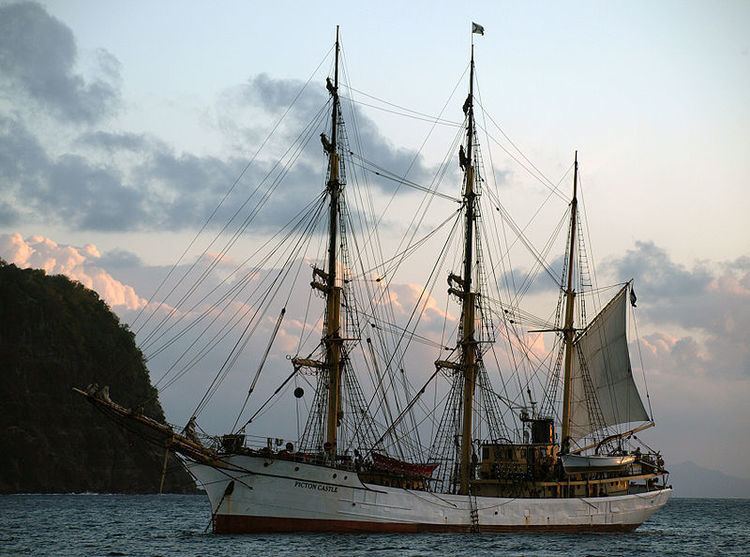 Similar Pride of Baltimore, USS Niagara (1813), USS Constitution | ||
Picton Castle is a fully certified and registered Cook Islands tall ship whose mission is deep-ocean sail training and long distance education voyages. Picton Castle is perhaps best known for her World Circumnavigations, though she has visited the Great Lakes twice, sailed numerous times on tours of the East Coast of the Americas, completed a Caribbean Voyage and in 2008 sailed to Europe, Africa and the Caribbean on a Voyage of the Atlantic. In 2012 she sailed for the South Pacific. Picton Castle's unofficial home port in Canada is Lunenburg, Nova Scotia, but she is formally registered in the Cook Islands and subject to that country's regulatory regime.
Contents
In 2001, a series called Tall Ship Chronicles followed Picton Castle on her second voyage around the world. The ship has carried out six world voyages to date - completing the sixth one in 2014. She will set sail on her 7th World Voyage on 1 November, 2017.
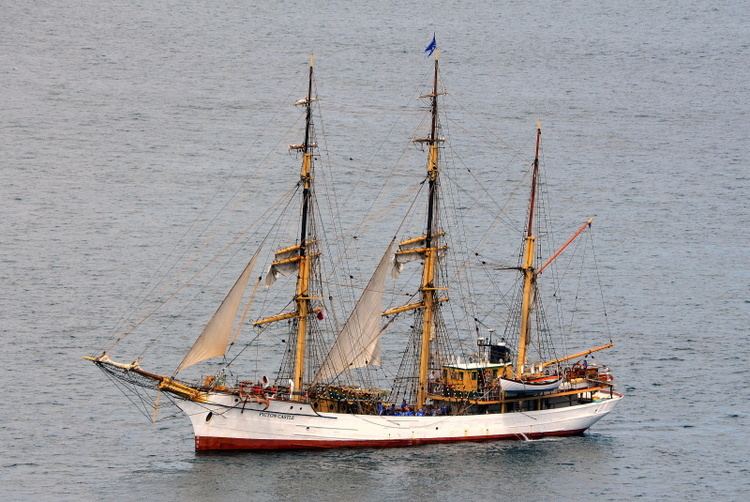
Picton Castle is rigged as a three-masted barque, is 179 feet (55 m) long, with a riveted steel hull, clear oiled pine decks, steel masts and wooden and steel yards. She carries 12,500 square feet (1,160 m2) of sail. The ship displaces 300 tons. She has a 690-horsepower diesel engine for the times when sailing is not feasible. The ship has space for roughly 52 people, consisting of about 12 professional crew and 40 sail trainees.
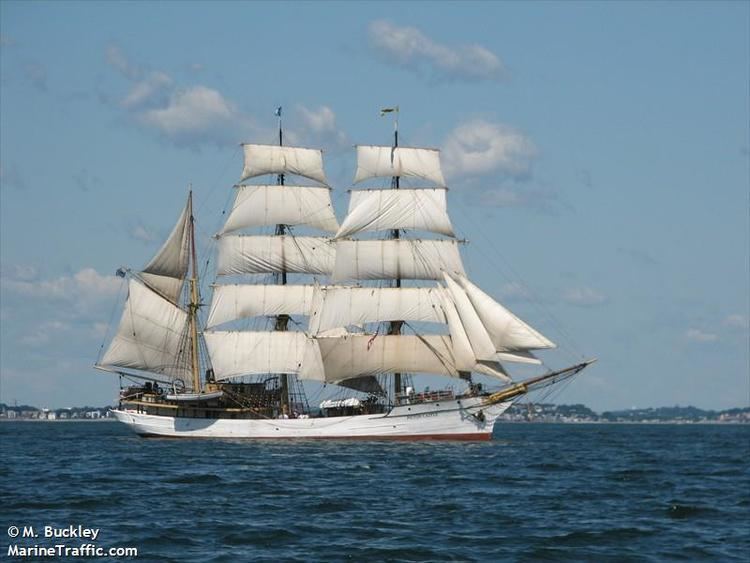
Picton Castle is a working tall ship. Sail trainee crew sign on with the knowledge that they will be participating fully in ship's operations. They stand watch, take turns at the helm, raise the anchor, clean the ship, haul on lines, handle sails, scrub the decks, participate in daily ships maintenance, help in the galley and keep lookout, among other things. The Captain and Mates conduct regular workshops designed to complement daily life on board. Workshops include seamanship, sail handling, sail making, ship maintenance, rigging, wire and rope splicing, knot tying, celestial navigation, plotting and chart work, rules of the road, weather, small boat handling, basic engineer and more. They also conduct regular safety drills onboard so that crew become familiar and comfortable with equipment and safety procedures. These drills include Fire, Man Overboard, and Abandon Ship.

As a trawler, minesweeper, and freighter
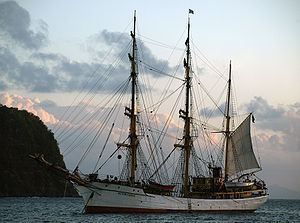
Picton Castle was originally built as a motorized fishing trawler in 1928. She was built along with four other trawlers for the same company and operated out of Swansea, Wales. The ship was named after the Welsh castle of the same name.
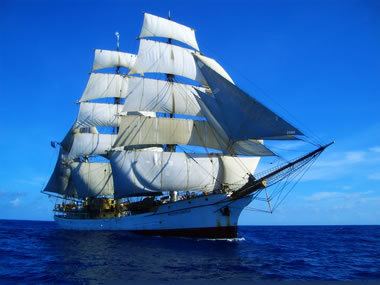
In August 1939, the Royal Navy requisitioned the trawler for use in World War II and refit her as a minesweeper. While sweeping mines near Norway, she made way for the port of Bergen for repairs. The Germans had just left Norway, and the sight of the Union Jack-bearing HMS Picton Castle earned her the title "The Liberator of Norway."
Following World War II, the ship was renamed Dolmar and worked as a freighter in the North Sea and Baltic Sea.
Acquisition and refit
During the early 1990s, Daniel Moreland acquired the ship while seeking a vessel to convert to a barque. With the help of a small crew he brought her across the Atlantic Ocean, eventually ending up in Lunenburg, Nova Scotia where she began her multimillion-dollar refit.
Picton Castle is still captained by Daniel Moreland.
As a sailing ship
Picton Castle's first world circumnavigation voyage took place from 1997-1999. She has since sailed around the world four more times, for a total of five global circumnavigations.
In September 2007, Picton Castle announced its first Voyage of the Atlantic. The ship embarked on May 2008 from its home port of Lunenburg, Nova Scotia and followed the Westerlies across the North Atlantic for the British Isles and Northern Europe. Then sailed across the English Channel and down the coast of France to Spain, Portugal, and Gibraltar. Explored the Atlantic Islands of Madeira, the Canary Islands and Cape Verde and followed in the wake of Columbus as the Picton Castle set sail on one of the finest studdingsail passages, riding the tropical trade-winds across the mid-Atlantic from Senegal, West Africa, crossing the Equator to Fernando De Noronha, Brazil and onward to the sweet isles of the West Indies.
During the summer of 2007, Picton Castle successfully completed its first Bosun School. The purpose of Bosun School is to provide an opportunity to young dedicated mariners to advance their skill level in a concentrated fashion without the natural demands and distractions of being underway at sea. A second Bosun School was held in the fall of 2009, and a third started in September 2011.
In the spring of 2007, Picton Castle was featured in Mark Burnett's CBS reality show Pirate Master. The show was filmed in the Caribbean island of Dominica and premiered May 31, 2007 in the spot previously occupied by Survivor.
On the night of December 8, 2006, as Picton Castle was roughly 760 miles (660 nmi) south-east of Cape Cod, Massachusetts, the ship encountered bad weather; a wave swamped the ship, sweeping overboard one of the professional crew, later identified as 25-year-old lead seaman Laura Gainey, daughter of Bob Gainey. She was not wearing a life jacket or a survival suit but, due to the warm water temperatures of 22 °C (72 °F) and her excellent physical condition, was expected to survive for up to 36 hours. She was able to call out while being swept overboard, and crew on the ship threw flotation devices and radar reflectors into the water to aid her and mark her position. Subsequent searching by Picton Castle, assisted by aircraft of the United States and Canadian Coast Guards, and nearby merchant vessels, was unsuccessful and called off after three days.
When Picton Castle arrived at St. Kitts on 24 December, an investigator of the Ministry of Transport for the Cook Islands, the ship's country of registry, came on board and started a preliminary investigation, which was finished on 19 February 2007. A Board of Marine Inquiry, after reviewing the preliminary investigation, issued a final report in summer 2007. An investigation titled "Overboard" by the CBC program The Fifth Estate, first aired on November 28, 2007, claimed to have uncovered serious safety problems with the ship. A few days before, the Transportation Safety Board of Canada (TSB), as an interested party given the close ties of the ship to Canada and given that both the ship's owner and the lost seaman are Canadian, began an independent investigation on November 18, 2007; they reviewed the report of the Cook Islands and issued their own Marine Investigation Report (M06F0024 - Crew Member Lost Overboard, sail training Vessel Picton Castle, 376 nm SSE of Lunenburg, Nova Scotia), released on July 24, 2008 and available on their website. The report found among the "causes and contributing factors" that the decision to set to sea did not sufficiently take into account the long-range weather forecasts, especially in view of the crew's qualification and experience; the lost deckhand did not get enough sleep in the 1-2 days before the accident; most likely miscommunication on the fatal evening resulted in her still getting up every hour instead of getting rest; the port breezeway of the ship was designated "off-limits" by the ship's master, but due to inefficient communication, the lost deckhand seems to have remained unaware of that order; in the heavy weather, no safety nets were rigged on the ship; safety lines were rigged, but safety harnesses were not worn, and there were no "established fastening points" (other than the safety lines) to which to clip safety harnesses.
Several measures were subsequently undertaken and procedures changed on the ship, to address some of the concerns and to generally improve safety on the ship (e.g., wearing safety harnesses at night and in heavy weather; monitoring fatigue of crew members; etc.).
In October 2013 Picton Castle participated in the International Fleet Review 2013, the centennial anniversary of the Royal Australian Navy, in Sydney, Australia along with fifteen other tall ships including the Sydney-based 19th century Barque James Craig (1874).
Picton Castle sailed in the South Pacific in 2013 and 2014, having left her home base in Lunenburg, Nova Scotia in November 2012, shortly after Hurricane Sandy. Starting in July 2014, she sailed west from Fiji, eventually returning to Lunenburg in late May, 2015. She was sailing in the North Atlantic in autumn of 2015.
